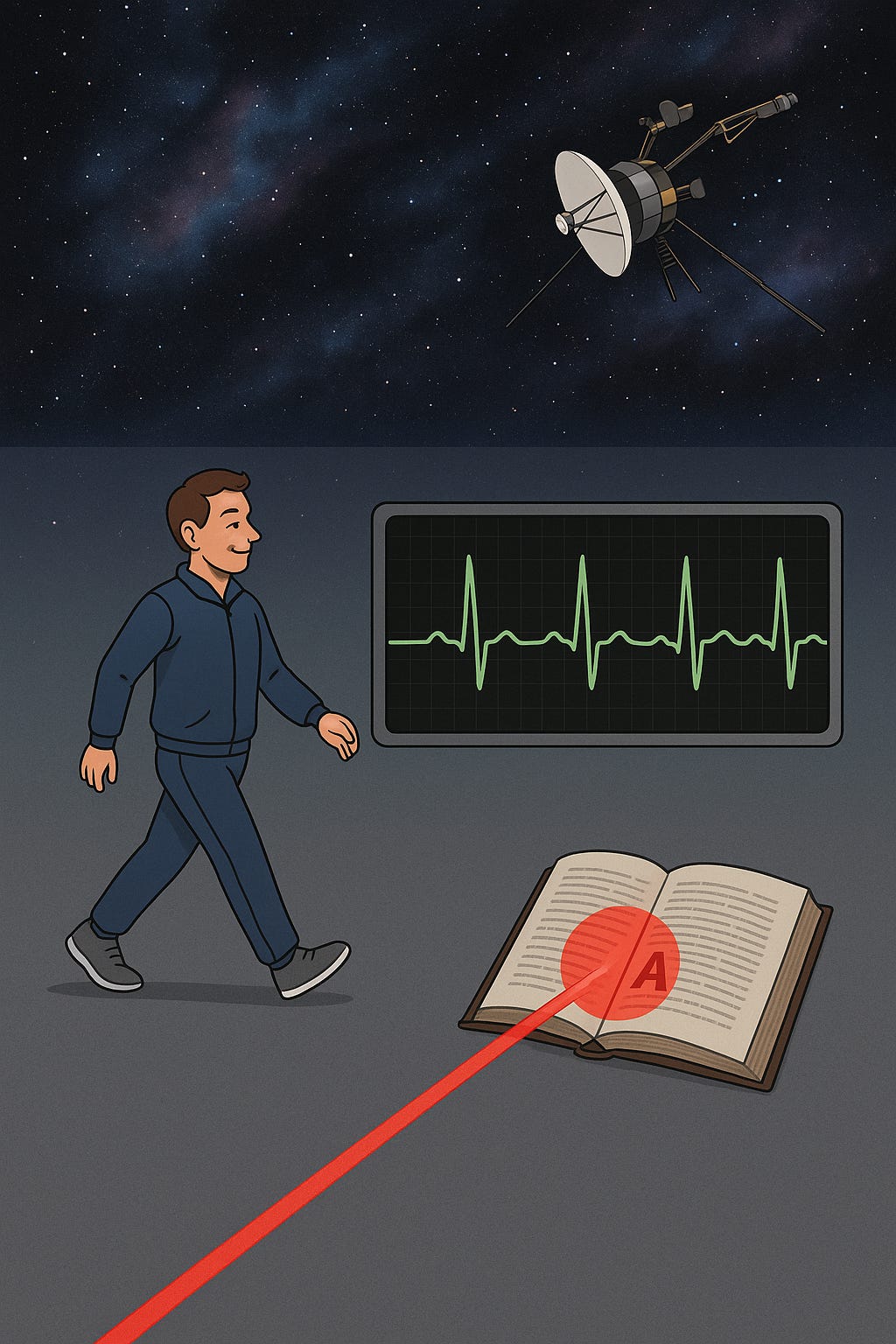This is another in an irregular series of posts built on short but pithy comments about current (or maybe future) tech. Or whatever else comes to my mind. Sometimes, I'm easily amused
When I do these things, I number the items. I've been numbering things for many years. By now it's traditional. Every item has a link to the article that inspired me to write about it.
1. Wearable Heart Attack Monitor
Let's start with a smart device - maybe a watch, maybe something else - that let's you know if you're having a heart attack. I know what you're thinking! Wouldn't the sound of your anguished groan and a desperate clutch at your chest be a clue?
Well let me tell you a story of a guy I worked with many years ago who we'll call Bill. Because if I called him Abel (for the first letter of the alphabet) I would then have to give the names of all his brothers, just so you wouldn't think I was telling some entirely different story with murder in it.
Bill was a nice guy who ran a big piece of industrial equipment. He started early in the morning and usually left a little earlier than those of us who didn't like coming in that early. One day, I noticed Bill sitting on a chair next to his equipment, looking pale and worried. As it happened, we had a guy working in the front office who had been a paramedic. I won't name him because there's just so many stories I can avoid here, okay?
Paramedic guy took Bill's vitals, spoke to him calmly and called an ambulance. Looked like maybe a heart attack. Except a few hours later, Bill was back to work! So I asked him about it. He was very upset but looked a lot better than he had. You know what they told him at the emergency room before kicking him out? "Lay off the caffeine."
Wouldn't it have been nice if Joe - I mean Bill! - had had a smart device that could tell him, "Nope! Not a heart attack. Your heart is good. But it wouldn't hurt anything to see a doctor. Trust me." You have to phrase it that way to avoid lawsuits when you're wrong. Not that it will work. There will still be lawsuits but at least you'll have some sort of defense when it gets to court.
One interesting thing mentioned in the article is that they didn't just use machine learning to make their device be able to detect heart attacks. They designed a whole new chip, too. It doesn't go into any detail about why this is a good thing. I'm sure it is though. After all, who would go to the trouble of making their device more expensive, with untried tech, if it wasn't important?
Anyway, this is part of a trend to wearable medical devices. It's a good trend. I'm sure Ted - I mean Bill! - wished he had one of those devices back then.
2. Use Lasers to Read Letters at a Distance
This one is a little less obviously practical. Some smart scientists developed a way to use infrared lasers and telescopes to gather very small images at a distance of a mile. In the tests, they had a target 8 mm wide (that's under one third of an inch). By hitting it with the laser and detecting the reflected light with multiple telescopes they could read the letter.
This is both easier and harder than just pointing a telescope at the target and reading it. It's easier because the size telescope you would need to read that letter is kind of ridiculous. And when you add in atmospheric effects (air moves even when it seems calm), you might not be able to get a usable image even if your telescope was big enough.
But it's harder because aiming at something less than an inch across from a mile away is hard. It's like, you need the result of the imaging just to be able to find what you're aiming at. Unless you have a computer and have already ranged the whole area. Then you can maybe fire at a pre-programmed target. Right?
The article says this could be used for detecting tiny bits of space debris. This is a problem in low earth orbit. We've been putting stuff up there for decades. Sometimes it breaks apart. Sometimes somebody shoots it, just to prove they can. And when you're going at 20,000 miles an hour just to stay in orbit, even a super small piece of debris can punch quite a hole in you. So you can see why people would want to detect little things before hitting them.
But I can't help thinking that in a few years, this will be some kind of privacy issue. Like government agents a mile off will still be able to use a laser to see what you're scrolling on your phone, or even check to see if your wearable health device says you need to cut down on the caffeine.
Too paranoid? Nah! This is the 21st century. I'm probably not paranoid enough!
Every once in a while Technoscreed likes to check in on the oldest and farthest away probes going. The Voyagers got sent off 50 years ago and are currently farther away, by a lot, than anything else the human race has put into space. Technically, they aren't even in the solar system anymore. Unless the solar system is bigger than we think, which is possible.
It seems that Voyager 1 developed a technical fault a little over 20 years ago that interfered with the rockets (they call them thrusters) that guide it. It mostly needs them so it can keep pointed true so that the antenna can still find Earth to send data back. Actually, the thrusters that died were the backup set. The main ones were still good.
Both Voyagers have been slowly losing capabilities for years, just because they were never intended or expected to still be going this long after launch. But the good people at NASA and JPL (Jet Propulsion Laboratory) have managed to keep from completely losing them. But the thrusters Voyager 1 has been using all this time are getting close to real end of life. Basically, the fuel lines are getting clogged and it's just too far to send a repair guy with a pipe cleaner1.
Once the thrusters go out, sooner or later, Voyager 1 will drift a little one way or the other and will lose contact with Earth, probably forever. But some genius figured out that the problem with the backup thrusters wasn't as bad as they thought 20 years ago. In March of this year, they were able to turn the things back on.
It was a little more complicated (and risky) than that sentence makes it sound but this is "Short Tech Stuff" not a "Tech Stuff that's as long as it needs to be to give all the gory technical details." Take my word for it that it was a neat trick.
They've extended the system life span ... some. Don't know how much but it's better than zero. I like to think that someday (hopefully this century), someone will send a repair crew out tot he Voyagers. They'll give them a refurb. Upgrade the computer systems. Fix the things that are broken. Replace the batteries with some that will keep going another million years. And put a plaque on each one saying, "If you're reading this, turn around and say hi. We're right behind you."
4. There is no four. See you next week!
Here's that prompt: "I need an image showing three things. Thing one is a person in a track suit who is just walking alone happily but being followed by a heart monitor. The monitor shows normal sinus rhythm. Thing two is a laser pointed at a book that is a distance away. Where the laser light hits, the letters in the book are bigger. Thing three is above the other things. The sky above them is outer space, with Voyager 1 passing through."
I don't usually make them quite this literal but this time it was all I could think of. It worked out okay.
Lest you forget that I write more (and sillier) stuff than just Technoscreed:
From the author of the Mauser and Keeg Adventures, Tree of Bones and Shadow of a Dream comes All Our Magic Dark and Strange, a collection of fantasy short stories all set in the same dark and strange world.
Maybe they could use a really long pipe cleaner?




